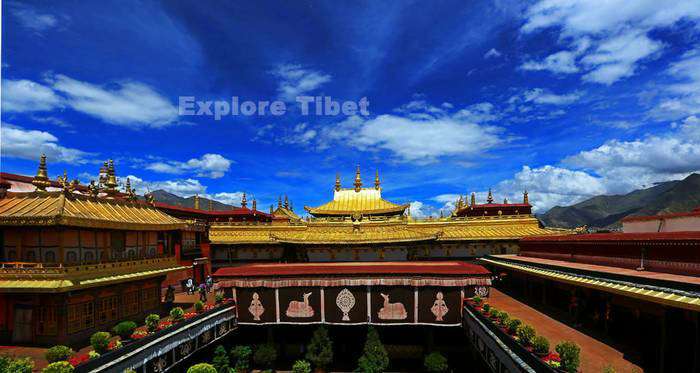
Jokhang Temple is also called Rasa Trulnang Tsuglhak Khang in Tibetan,it is located right in the centre of the old Lhasa encircled by Bakhor street, it is the oldest Buddhist temple in Tibet that erected in 7th century during the reign of king Songtsen Gampo and Samye monastery is the oldest Buddhist monastery that erect in 8thcentury, since then it is one of the focal point of Tibetan pilgrims throughout the Tibetan plateau, a Tibetan saying goes “ trip to Lhasa without visiting Jokhang temple is meaningless”, so in the early days, there is a tradition that every one visit twice to the Jokhang temple on every single trip to Lhasa, one at the arrival and another at the departure. For centuries, the long lines of pilgrims infront of the Jokhang temple to see the Sakya Muni image and bustling Bakhor street with pilgrims circumambulating the temple remain unchanged, the burning of incense right around the temple never had stop even a single day.
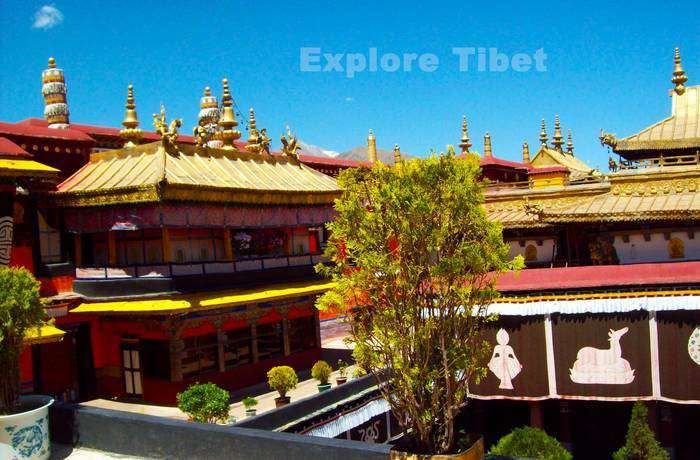
History of Jokhang Temple in Lhasa
The exact date of the Jokhang temple erection is different in the history, but mostly agreed it was founded between 639 to 647 AD, during the reign of 33rdTibetan king Songtsen Gampo, he unified whole Tibet and tried to introduce Buddhism in Tibet, so he married with two princesses of the neighboring Nepal kingdom and Tang Dynasty, the Jokhang temple was built by his Nepalese wife princess Bhrikuti to house the image of Akshobhya Buddha that brought to Tibet as part of her dowry, at the same time, his Chinese wife princess Wencheng from Tang Dynasty also brough the Sakya Muni Buddha image with her and built the Ramoche temple to house her Buddha image.
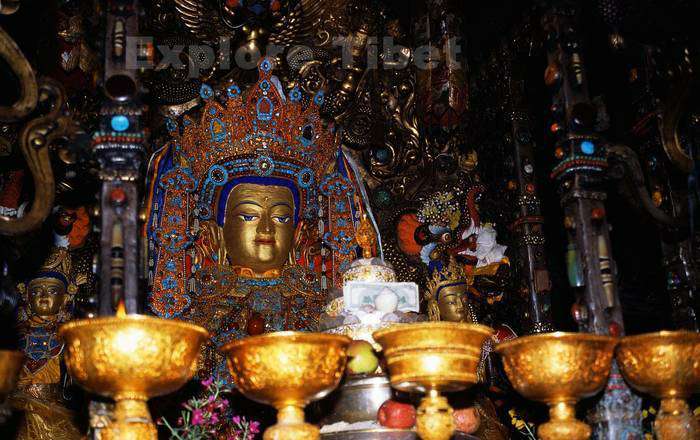
During the time of Jokhang temple construction, prince Wencheng computed her astrological calculation and resulted that the whole Tibet territory is in a position of supine demon, where Othang lake is exactly coincide the heart of the demon, so the Othang lake was filled by earth and stones transported by scared goat, the naturally formed image of the sacred goat can be seen inside Jokhang on a rock, then the Jokhang temple was built over the lake.
After the Songtsen Gampo’s death, the new emperor of the Tang Dynasty wanted the image back and sent people several times get it back, so the princess Wencheng had moved the Sakya Muni Buddha image from Ramoche to Jokhang temple for protection and hidden it within a wall in it, later it was brought out, since then the image had remained in the Jokhang temple.
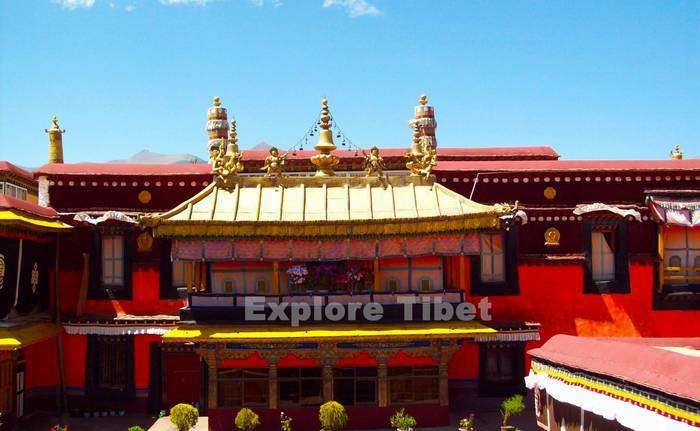
The Jokhang temple is a four-storey construction, with roofs covered with gilded bronze tiles. The architectural style is based on the Indian vihara design, and was later extended resulting in a blend of Nepalese and Tang Dynasty styles, princess Bhrikuti had brought Newari artisans from Kathmandu valley during the constructions and also the temple is facing east-west towards Kathmandu to honor her home country.
Over the centuries from its construction it was under taken several renovations in different period of time but the original structure is well preserved, during the Culture Revolution, images were badly damaged and the temple itself was made to pigsty, and some of the chapels were well known as guesthouse number 5 during that time. Then the most recent and extensive renovations were under taken in 1992, 1994 and 2010.
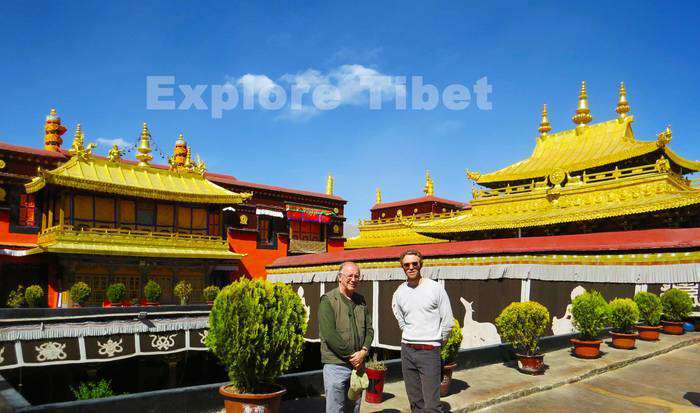
The inner Jokhang of three storey forms a square (82.5 square meter) enclosing the main assembly hall and the main shrine for the Sakya Muni Buddha is known as Kyilkhor Thil (bottom of the Mandala). This structure is encircled by the Nangkhor (inner circumambulation), in the outermost is the two storeyed western extension, which consist storerooms, kitchen, secondary assembly hall and chapels, residential quarters of the Dalai Lamas as well as ordinary monks and toilets. The Muru Nyingpa temple is also part of the Jokhang that adjoin it from the east side. This whole structure of Jokhang temple is enclosed by the circumambulation pathway which called as Bakhor (middle circuit), this circuit is known as one of the most devotional circuit that always bustling by local pilgrims.
In front of the Jokhang temple is the plaza, which was a Methok Dumra (flower garden) but recently reconstructed into a open square same as in front of Tiannanmen and Potala palace, right in front of the central entrance is the stump of willow reputedly planted by Princess Wencheng in 7th century that flanked by another two willows that recently planted, the stele just in front of the willow was admonishing against the smallpox that erected in 1794, and enclosed within a new stone wall, on the left side there is six meter stele in the adjacent enclosure, it is the commemorating the Sino-Tibet peace treaty of 821/822 during the reign of king Triralpachen, a small semi-basement in front of the willow enclosure is made for offering butter lamps instead of inside the temple.
In these days, the area around the doorway of the central entrance mostly bursting with locals doing full stretch prostration and the Bakhor street is bustling by pilgrims murmuring mantras almost every day, the two incense burner on the two sides of the semi-basement and other three around the Bakhor street is hard to see without smoke, so naturally this temple become the most active ritual place in overall Tibet and it receive pilgrims from every corner of Tibet, specially in the winter.
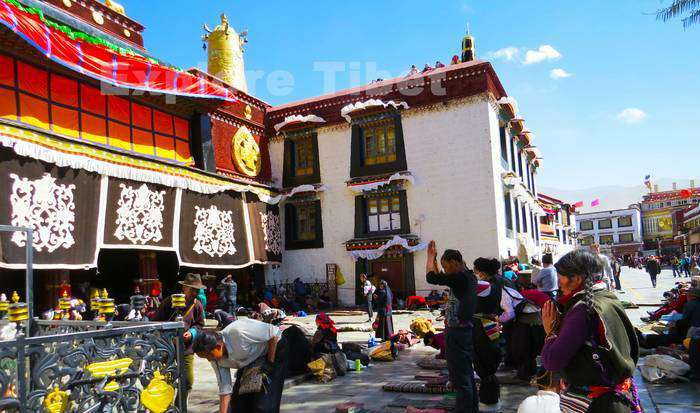
With its predominant Buddhist tradition, Tibet has the largest concentration of monasteries and temples than anywhere else on earth. Many of them are easily few hundred years old. Out of thousands of holy Buddhist sites, Jokhang Temple is considered to be the most sacred one. It is the Mecca of Tibetan Buddhism, which all the Tibetans must visit at least once in their lifetime.
Jokhang in Tibetan means the “the House of Jowo” Jowo here is referred to the Buddha statue of Jowo Shakyamuni, the undisputedly most venerated object in Tibetan Buddhism. The precious statue of Buddha depicting the Lord Buddha aged twelve was presented to the Tibetan King Songtsen Gampo by Chinese princess Wencheng as a part of her dowries when she got married to the King in seventh century.
The Jokhang Temple construction was started by King Songtsen Gampo approximately in the year of 642 to house the Jowo Shakyamuni stature. One historical narration also states that besides housing the precious statues of Jowo, the Temple was built for the two brides of the King, the Chinese Prince Wancheng, and Princess Bhrituti of Nepal.
Apart from the sacred statue of Jowo Shakyamuni, there are also other precious statues of Chenresig, Guru Padmasambhava, and King Sontsen Gampo and his two foreign princesses. Most of the original statues were destroyed during the Cultural Revolution, but they were recreated later by including the broken pieces of the original statues. On the third floor of the temple there is an image of Palden Lhamo, a fierce protector of both Lhasa and the Dalai Lama.
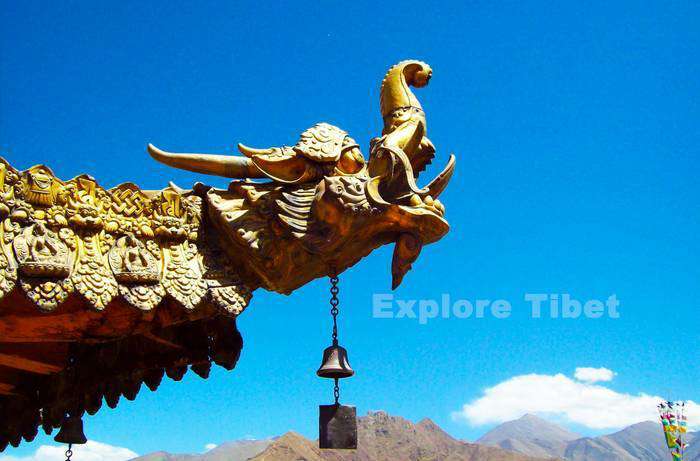
The location of the sacred temple is carefully chosen as the middle of the Lhasa at the time of construction. Today we find it located on the historical Barkhor Square in the old section of Lhasa. The total area of the temple is about 25,000 square meters, with Barkhor Street circulating the entire temple.
The beautiful architectural style of the Jokhang is based on the Indian vihara design blended with Nepalses and Tang Dynasty styles. The most iconic external design of the temple is the statues of two golden deer flanking a Dharma wheel at the rooftop of the main entrance.
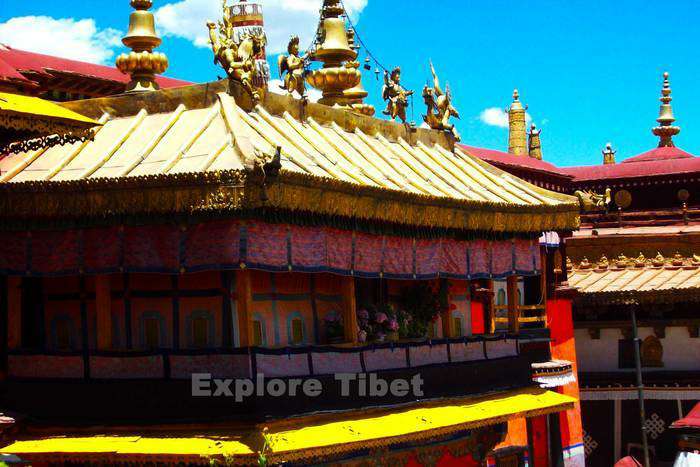
Jokhang Temple is part of the UNESCO World Heritage Site “Historic Ensemble of the Potala Palace,” Potala Palace and
Jokhang Temple are the twin most popular Lhasa attraction in Tibet. If you can find a good tourist guide during the visit,
you will have the chance to learn a thorough history of Tibetan Buddhism. If you want to know more about Jokhang Temple or planning to visit Tibet, you can contact us at [email protected] so that we can help you to provide guidelines during your stay.
